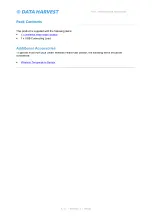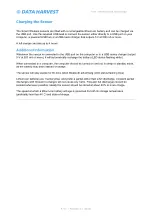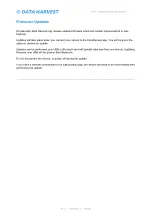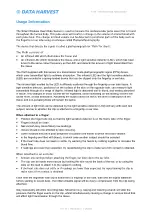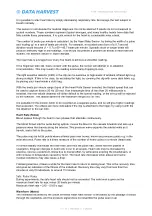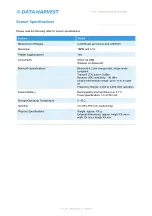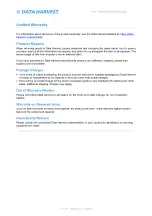
1156 - Wireless Heart Rate Sensor
10 / 21 | Revision: 0 | DS033
Usage Information
The
Smart Wireless Heart Rate Sensor
is used to measure the cardiovascular pulse wave that is found
throughout the human body. This pulse wave will result in a change in the volume of arterial blood with
each pulse beat. This change in blood volume can be detected in peripheral parts of the body such as
the fingertip or ear lobe using a technique called Photoplethysmography.
The device that detects the signal is called a plethysmograph (or ‘Pleth’ for short).
The Pleth consists of:
·
An infrared LED which illuminates the tissue and
·
An infrared LED which illuminates the tissue, and a light sensitive detector (LSD), which has been
tuned to the same colour frequency as the LED, and detects the amount of light transmitted from
the tissue.
The Pleth supplied with this sensor is a transmission mode plethysmographic signal (PPG) device,
which uses transmitted light to estimate absorption. The infrared LED and the light sensitive detector
(LSD) are mounted in a spring-loaded device that can be clipped onto the fingertip or ear lobe.
The infrared light emitted by the LED is diffusely scattered through the fingertip or ear lobe tissue. A
light sensitive detector, positioned on the surface of the skin on the opposite side, can measure light
transmitted through at a range of depths. Infrared light is absorbed well in blood, and weakly absorbed
in tissue. Any changes in blood volume will be registered, since increasing (or decreasing) volume will
cause more, or less absorption. Assuming the subject does not move, the level of absorption of the
tissue and non-pulsating fluids will remain the same.
The amount of light that can be detected by the light sensitive detector (LSD) will vary with each test
subject, and as to whether the clip is attached to a fingertip or ear lobe.
When attached to a finger:
·
Position the finger lobe clip so that the light sensitive detector is on the fleshy side of the finger.
·
Fingers should be clean.
·
Nail varnish may cause falsely low readings.
·
Values should not be affected by skin colouring.
·
Some subjects may have poor peripheral circulation (the extent to which the blood vessels
·
in the fingertip are filled with blood), in which case another subject should be selected.
·
If the heart rate does not seem to settle, try warming the hands by rubbing together to increase the
blood flow.
·
If readings are lower than expected, try repositioning the clip to make sure firm contact is obtained.
When attached to an ear lobe:
·
Remove any earrings before attaching the finger/ear lobe clip to the ear lobe.
·
The clip can be made more secure by hooking the wire round the back of the ear, or by using the
slide on the lead to attach it to the subject’s clothing.
·
If the heart rate does not settle or if readings are lower than expected, try repositioning the clip to
make sure a firm contact is obtained.
Each time the finger/ear lobe clip is attached to a fingertip or ear lobe, wait until the signal stabilises
before starting to record data - the initial unstable signal will be due to compression from the clip being
attached.
Stay reasonably still while recording data. Movement e.g. raising and lowering a hand, will alter the
pressure that the finger exerts on the clip, whilst simultaneously causing a change in venous blood that
will affect light transmission through the tissue.




